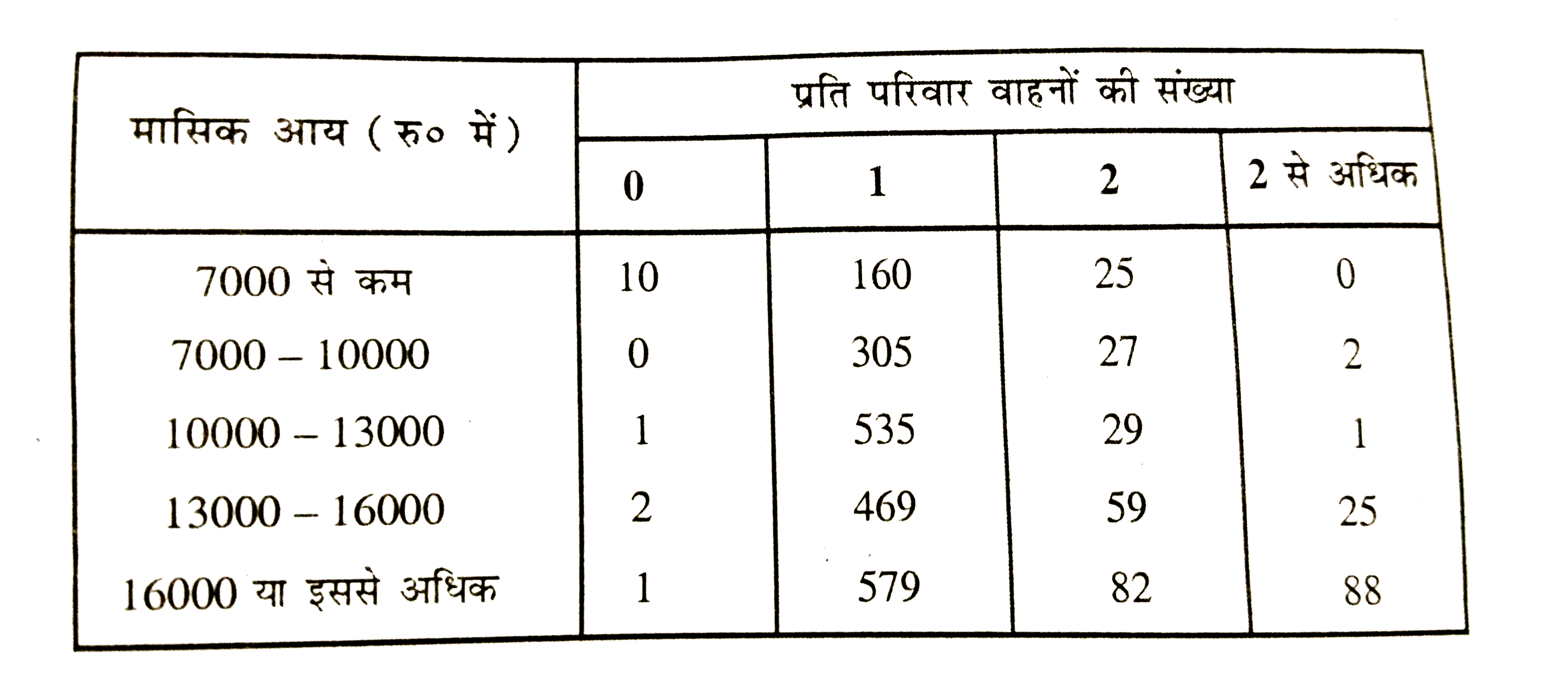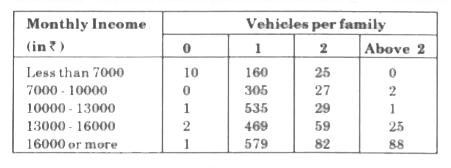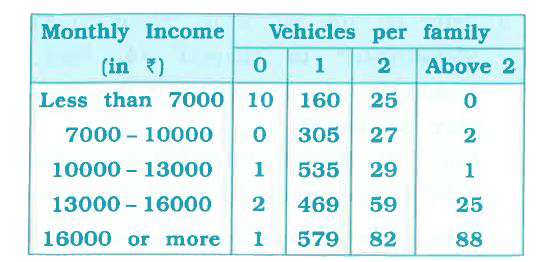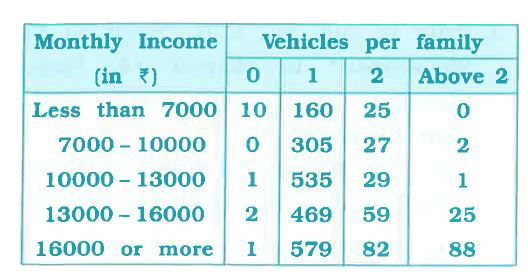A company selected 2400 families at random and survey them to determine a relationship between income level and the number of vehicles in a home. The information gathered is listed in the table below: Monthly income (in Rs.) Vehicles per family 0 1 2 Above 2 Less than 7000 10 160 25 0 7000-10000 0 305 27 2 10000-13000 1 535 29 1 13000-16000 2 469 29 25 16000 or more 1 579 82 88 If a family is chosen, find the probability that the family is: earning Rs. 10000-13000 per month and owning exactly 2 vehicles. earning Rs. 16000 or more per month and owning exactly 1 vehicles. Earning less than Rs. 7000 per month and does not own any vehicle. Earning Rs. 13000-16000 per month and owning more than 2 vehicle. owning not more than 1 vehicle owning at least one vehicle.
To solve the problem, we will calculate the probabilities step by step for each part of the question based on the data provided in the table.
1. Probability of earning Rs. 10,000-13,000 per month and owning exactly 2 vehicles:
- From the table, the number of families earning Rs. 10,000-13,000 and owning exactly 2 vehicles is 29.
- Total number of families surveyed = 2400.
- Probability = (Number of families earning Rs. 10,000-13,000 and owning 2 vehicles) / (Total number of families)
- Probability = 29 / 2400
- Final Answer: P(A)=292400
2. Probability of earning Rs. 16,000 or more per month and owning exactly 1 vehicle:
- From the table, the number of families earning Rs. 16,000 or more and owning exactly 1 vehicle is 579.
- Probability = (Number of families earning Rs. 16,000 or more and owning 1 vehicle) / (Total number of families)
- Probability = 579 / 2400
- Final Answer: P(B)=5792400
3. Probability of earning less than Rs. 7,000 per month and not owning any vehicle:
- From the table, the number of families earning less than Rs. 7,000 and owning 0 vehicles is 10.
- Probability = (Number of families earning less than Rs. 7,000 and owning 0 vehicles) / (Total number of families)
- Probability = 10 / 2400
- Final Answer: P(C)=102400=1240
4. Probability of earning Rs. 13,000-16,000 per month and owning more than 2 vehicles:
- From the table, the number of families earning Rs. 13,000-16,000 and owning more than 2 vehicles is 25.
- Probability = (Number of families earning Rs. 13,000-16,000 and owning more than 2 vehicles) / (Total number of families)
- Probability = 25 / 2400
- Final Answer: P(D)=252400
5. Probability of owning not more than 1 vehicle:
- We need to sum the families owning 0 and 1 vehicle across all income levels:
- 0 vehicles (less than 7000): 10
- 1 vehicle (less than 7000): 160
- 1 vehicle (7000-10000): 305
- 1 vehicle (10000-13000): 535
- 1 vehicle (13000-16000): 469
- 1 vehicle (16000 or more): 579
- Total families owning not more than 1 vehicle = 10 + 160 + 0 + 305 + 1 + 2 + 1 + 2 + 1 + 2 + 1 + 579 = 2062.
- Probability = (Number of families owning not more than 1 vehicle) / (Total number of families)
- Probability = 2062 / 2400
- Final Answer: P(E)=20622400=10311200
Summary of Probabilities:
- P(A)=292400
- P(B)=5792400
- P(C)=1240
- P(D)=252400
- P(E)=10311200
- From the table, the number of families earning Rs. 10,000-13,000 and owning exactly 2 vehicles is 29.
- Total number of families surveyed = 2400.
- Probability = (Number of families earning Rs. 10,000-13,000 and owning 2 vehicles) / (Total number of families)
- Probability = 29 / 2400
- Final Answer: P(A)=292400
- From the table, the number of families earning Rs. 16,000 or more and owning exactly 1 vehicle is 579.
- Probability = (Number of families earning Rs. 16,000 or more and owning 1 vehicle) / (Total number of families)
- Probability = 579 / 2400
- Final Answer: P(B)=5792400
- From the table, the number of families earning less than Rs. 7,000 and owning 0 vehicles is 10.
- Probability = (Number of families earning less than Rs. 7,000 and owning 0 vehicles) / (Total number of families)
- Probability = 10 / 2400
- Final Answer: P(C)=102400=1240
- From the table, the number of families earning Rs. 13,000-16,000 and owning more than 2 vehicles is 25.
- Probability = (Number of families earning Rs. 13,000-16,000 and owning more than 2 vehicles) / (Total number of families)
- Probability = 25 / 2400
- Final Answer: P(D)=252400
- We need to sum the families owning 0 and 1 vehicle across all income levels:
- 0 vehicles (less than 7000): 10
- 1 vehicle (less than 7000): 160
- 1 vehicle (7000-10000): 305
- 1 vehicle (10000-13000): 535
- 1 vehicle (13000-16000): 469
- 1 vehicle (16000 or more): 579
- Total families owning not more than 1 vehicle = 10 + 160 + 0 + 305 + 1 + 2 + 1 + 2 + 1 + 2 + 1 + 579 = 2062.
- Probability = (Number of families owning not more than 1 vehicle) / (Total number of families)
- Probability = 2062 / 2400
- Final Answer: P(E)=20622400=10311200
- P(A)=292400
- P(B)=5792400
- P(C)=1240
- P(D)=252400
- P(E)=10311200
Topper's Solved these Questions
Similar Questions
Represent √6, √7, √8 on the number line.
View SolutionThe sides AB and CD of a parallelogram ABCD are bisected at EandF . Prove that EBFD is a parallelogram.
View SolutionA company selected 2300 families at random and surveyed them to determine a relationship between income level and the number of vehicles in a home The information gathered is listed in the table below : if a family is chosen at random, find the probability that the family is: (i) earning Rs.7000-13000 per month and owning exactly 1 vehicle (ii) owning not more than one vehicles. more than 2 vehicles (lii) earning more than Rs. 13000 and owning 2 or (iv) owning no vehicle
View SolutionA company selected 2400 families at random and survey them to determine a relationship between income level and the number of vehicles in a home. The information gathered is listed in the table below: Monthly income (in Rs.) Vehicles per family 0 1 2 Above 2 Less than 7000 7000-10000 10000-13000 13000-16000 16000 or more 10 0 1 2 1 160 305 535 469 579 25 27 29 29 82 0 2 1 25 88 If a family is chosen, find the probability that the family is: (i) earning Rs. 10000-13000 per month and owning exactly 2 vehicles. (ii) earning Rs. 16000 or more per month and owning exactly 1 vehicle (iii) Earning less than Rs. 7000 per month and does not own any vehicle. (iv) earning Rs. 13000-16000 per month and owning more than 2 vehicle. (v) owning not more than 1 vehicle. (vi) owning at least one vehicle.
View SolutionA company selected 2400 families at random and survey them to determine a relationship between income level and the number of vehicles in a home. The information gathered is listed in the table below: Monthly income (in Rs.) Vehicles per family 0 1 2 Above 2 Less than 7000 10 160 25 0 7000-10000 0 305 27 2 10000-13000 1 535 29 1 13000-16000 2 469 29 25 16000 or more 1 579 82 88 If a family is chosen, find the probability that the family is: earning Rs. 10000-13000 per month and owning exactly 2 vehicles. earning Rs. 16000 or more per month and owning exactly 1 vehicles. Earning less than Rs. 7000 per month and does not own any vehicle. Earning Rs. 13000-16000 per month and owning more than 2 vehicle. owning not more than 1 vehicle owning at least one vehicle.
View SolutionAn organisation selected 2400 families at random and surveyed them to determine relationship between income level and the number of vechicles in a family. The information gathered is listed in the table below:

Suppose a family is chosen. Find the probability that the family chosen is :
(i) earning Rs. 10000-13000 per month and owning exactly 2 vehicles.
(ii) earning Rs. 16000 or more per month and owning exactly 1 vehicle.
(iii) earning less than Rs. 7000 per month and does not own any vehicle.
(iv) earning Rs. 13000-16000 per month and owning more than 2 vehicles.
(v) owning not more than 1 vehicle.
View Solutionएक कंपनी ने यदृच्छया 2400 परिवार चुनकर एक घर की आय स्तर और वाहनों की संख्या के बीच संबंध स्थापित करने के लिए उनका सर्वेक्षण किया। एकत्रित किए गए आँकड़े नीचे सारणी में दिए गए है :

मान लीजिए एक परिवार चुना गया है। प्रायिकता ज्ञात कीजिए कि चुने गए परिवार
(i) की आय 10000 - 13000 रु. प्रति माह है और उसके पास ठीक-ठीक दो वाहन है।
(ii) की आय प्रति माह 16000 रु. या इससे अधिक है और उसके पास ठीक 1 वाहन है।
(iii) की आय 7000 रु. प्रति माह से कम है और उसके पास कोई वाहन नहीं है।
(iv) की आय 13000 - 16000 रु. प्रति माह है और उसके पास 2 से अधिक वाहन है।
(v) के पास 1 से अधिक वाहन नहीं है।
View SolutionAn organisation selected 2400 families at random and surveyed them to determine a relationship between income level and the number of vehicles in a family . The information gathered is listed in the table below:

Suppose a family is chosen . Find the probability that the family chosen is
earning Rs 10000 - 13000 per month and owning exactly 2 vehicles.
View SolutionAn organisation selected 2400 families at random and surveyed them to determine a relationship between income level and the number of vehicles in a family . The information gathered is listed in the table below:

Suppose a family is chosen . Find the probability that the family chosen is
earning Rs 13000-16000 per month and owning more than 2 vehicles.
View SolutionAn organization selected 2400 families at random and surveyed them to determine a relationship between level and the number of vehicles in a family. The information gathered is listed in the table below

Suppose a family is chosen. Find the probability that the family chosen is :
(i) earning Rs 10000-13000 per month and owing exactly 2 vehicles.
(ii) earning Rs 16000 ro more per month and owning exactly 2 vehicle.
(iii) earning less than Rs 7000 per month and odes not own andy vehicle.
(iv) earning Rs 13000-16000 per month and owning more than 2 vehicles.
(v) owning not more than 1 vehicles.
View SolutionA company selected 2400 families at random and survey them to determine a relationship between income level and the number of vehicles in a home. The information gathered is listed in the table below: If a family is chosen, find the probability that the family is: (i) earning Rs.10000-13000 per month and owning exactly 2 vehicles. (ii) earning Rs. 16000 or more per month and owning exactly 1 vehicle (iii) Earning less than Rs. 7000 per month and does not own any vehicle. (iv) earning Rs.13000-16000 per month and owning more than 2 vehicle. (v) owning not more than 1 vehicle. (vi) owning at least one vehicle.
View SolutionAn organisation selected 2400 families at random and surveyed them to determine a relationship between income level and the number of vehicles in a family . The information gathered is listed in the table below

Suppose a family is chosen, Find probability that the family chosen is
earning Rs 10000 - Rs 13000 per month and owning exactly 2 vehicles.
View SolutionAn organisation selected 2400 families at random and surveyed them to determine a relationship between income level and the number of vehicles in a family . The information gathered is listed in the table below

Suppose a family is chosen, Find probability that the family chosen is
earning Rs 13000 - Rs 16000 per month and owning more than 2 vehicles.
View SolutionAn organisation selected 2400 families at random and surveyed them to determine a relationship between income level and the number of vehicles in a family . The information gathered is listed in the table below

Suppose a family is chosen, Find probability that the family chosen is
earning Rs 10000 - Rs 13000 per month and owning exactly 2 vehicles.
View SolutionAn organisation selected 2400 families at random and surveyed them to determine a relationship between income level and the number of vehicles in a family . The information gathered is listed in the table below

Suppose a family is chosen, Find probability that the family chosen is
earning Rs 16000 or more per month and owning exactly 1 vehicle.
View Solution